Let’s start with the admission of guilt. This traditional pasta dish from the province of Matera (and surrounds) in Basilicata, southern Italy, is “supposed” to be made with troccoli. Not with spaghetti alla chitarra. But I’m using the latter, because it’s as close as I’m going to get given circumstances. Now, it’s not that there’s a huge difference.
[These two photos are lifted from the internet, they’re not mine. The first from an Italian site called La Cucina Pugliese, the second from our local version of eBay, MercadoLibre. The mattarello, or rolling pin, for making troccoli is, as you can see, a grooved one (you first roll out the pasta sheet with a regular one), which cuts through the sheet of pasta, resulting in a squared off… spaghetti… with the upper edge being slightly rounded because of the shape of the grooves. The chitarra, or guitar, on the other hand, simply cuts the pasta sheet into square cross-section noodles, with all four edges being, more or less, sharp. At least as sharp as pasta can be.
Basically (photo again lifted from out a home design site, livehome3d), you end up with a cross-section that’s something like this. And that, as best I know, is the only difference between the two. I could get a troccoli mattarello, or at least something close to it, here, but for the one time use when I have a chitarra, it’s not worth the expense. Live with it.
This week’s pasta is Troccoli con baccalà, pasta shape caveat already covered. And this photo is a block of baccalà, or salt cod. It’s cod that’s been basically buried in salt to completely dry it out. It’s quite popular in Mediterranean cuisine. Locally we don’t see it much, though it is available.
When I was in São Paulo last month, it was everywhere.
The salt cod needs to be de-salted. There are numerous methods, and while this is not the quickest, it produces the best, most even, results. Rinse the block of salt cod off, to get rid of all the surface salt, then put it in a container filled with fresh water and stick it in the refrigerator. Every 6-8 hours, drain off the water and refill it. I tend to flip it over each time too, just to make sure the surfaces get even exposure. For two days. So somewhere around 6-8 refreshes of water. And then, we’re ready to make pasta.
Doesn’t that look more like a piece of fresh fish? Still not the same – the texture stays much firmer, because so much of the moisture within the cells has been removed, and the rehydration is more between the cells. It also has a different flavor from fresh cod.
What else do we need? Our troccoli or spaghetti alla chitarra in this case (and, by the way, it’s not uncommon even in southern Italy to use that; not everyone has a specialized rolling pin) made with just semolina, water, and a pinch of salt. A can of peeled San Marzano type tomatoes, parsley, the salt cod, garlic, chilies, and some semolina flour.
First step, cut the salt cod in cubes, coat them with the semolina, and fry them in a little olive oil until golden brown. Set aside.
Sauté the sliced garlic and chilies in a little olive oil until just starting to brown.
Add the tomatoes. You could use fresh tomatoes here too, preferably peeled.
Cook down over low heat for about 10-15 minutes until they’re falling apart.
Add the fried salt cod into the pan. This is a good point to drop your pasta into your boiling salted water. As the sauce cooks, the cod will start to flake apart. Add a little of the starchy pasta water and stir vigorously to emuslify.
And that should end up with a sauce that looks like this.
When the pasta is almost done, scoop it out and add it to the sauce along with a little more of the pasta water, and let it finish cooking in the sauce, stirring and tossing until the sauce is thickened and clinging to the pasta.
Add a generous amount of chopped parsley, get it all mixed in there. Adjust your seasoning with salt if needed, and a few grinds of black pepper.
And… serve.
This is one of my favorite pastas (then again, most pastas seem to be one of my favorites… I do like pasta). The richness from the flaked cod, the hit of spice from both garlic and chilies, all balanced against the acidity of the tomatoes and that creamy texture… yum!
Probably the best known wine from Basilicata is the Aglianico del Vulture. Not available here, but my friends over at Bodega Krontiras produce three different Aglianicos in Mendoza. As best I know, they’re the only Aglianicos produced in Argentina (I think at one point Zuccardi produced one too, but I’m not sure about that). I was able to lay my hands on two of them to accompany the pasta. The first, their organic “pet nat” Áfron, a naturally fermented sparkling rosé. I thought that this one would be the better match for the pasta, but delicious as it was, I found it too high in acidity to pair well with the dish. Surprisingly, that richness, saltiness, and intense umami of the pasta sauce paired extraordinarily well with the full on red from their Doña Silvina line. And the little bit of age on it, being a 2017, had it beautifully mellowed out. What a great wine and a great match! Not that over a couple of days I didn’t finish off both.
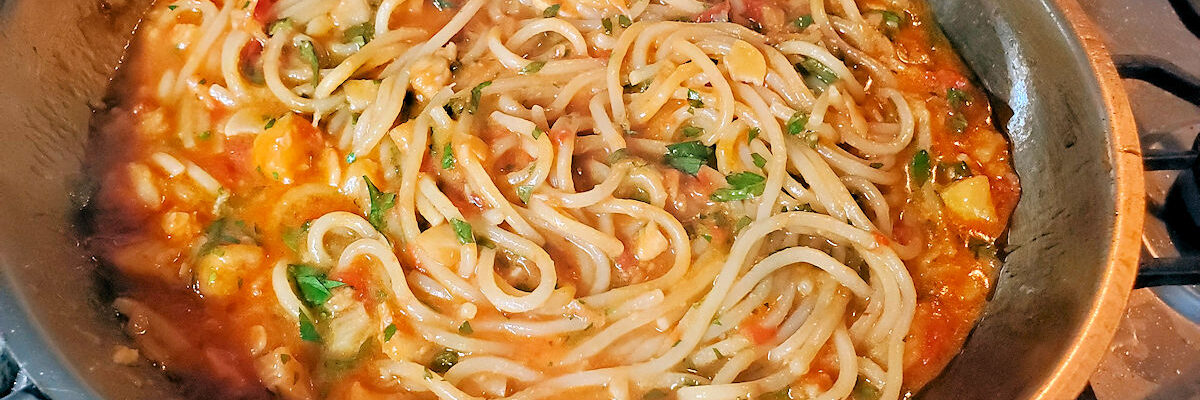
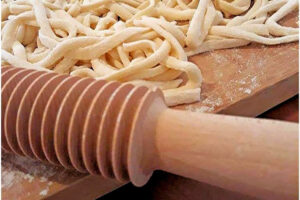
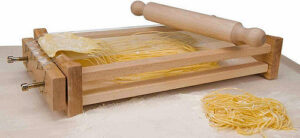

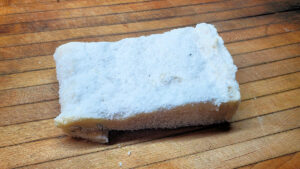
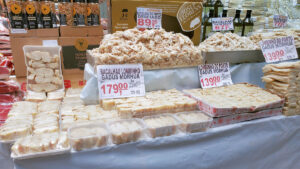
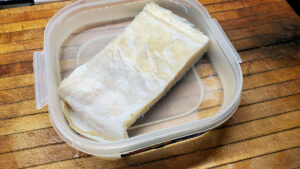
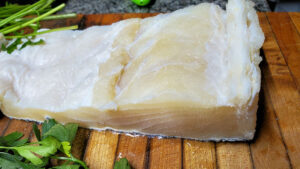
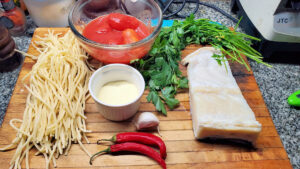
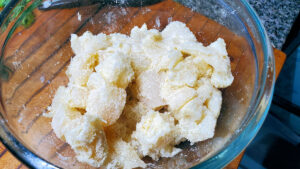
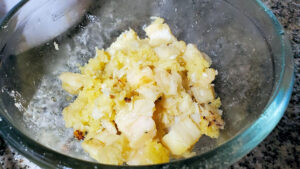
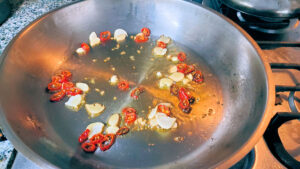
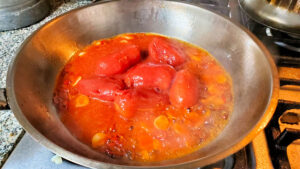
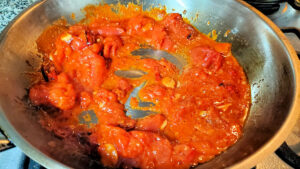
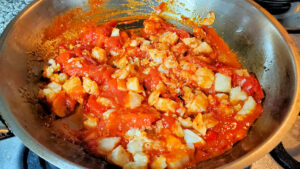
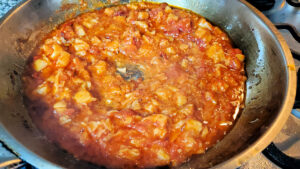
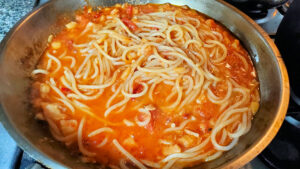
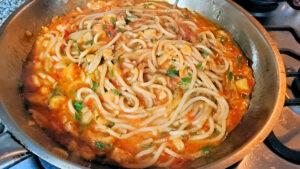
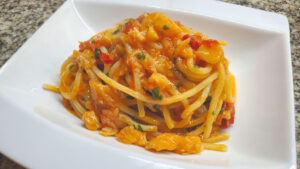
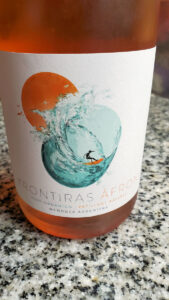
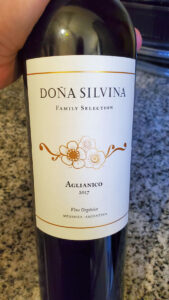
That looks tasty! And it has to be a first for you — something with no dairy, no pork.
I was sort of surprised at the cost of bacalao in Brazil. Last Christmas, the most deluxe version, legitimate Norwegian loin, went for around $20 USD/kilo in Mexico.
Given that cheese is present as an addition to many pastas, the no dairy thing hasn’t been common – though there have been several that I’ve presented that had no cheese, butter, or other dairy – like spaghetti all’assassina, spaghettii alla tarantina, pici alle briciole, spaghetti alla colatura di alici – and a few more. And even more that haven’t included pork. So not really a first. But yes, there were a spate recently that included both – mostly because I was covering two particular regions where those types of pastas are common.
In terms of cost – sure, imported Scandinavian salt cod is more expensive in Latin America than locally produced, but what makes it any more legitimate than the local salt cod? That seems a suprisingly eurocentric point of view. It’s not like the Norwegians invented salt-preserving of fish.